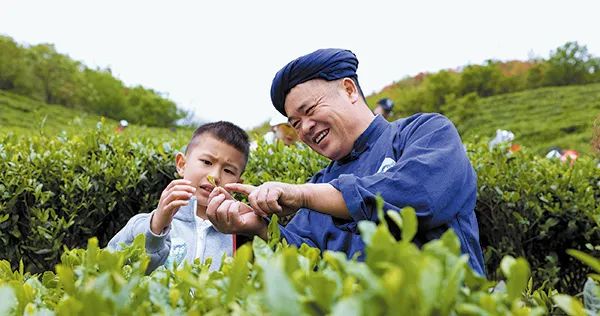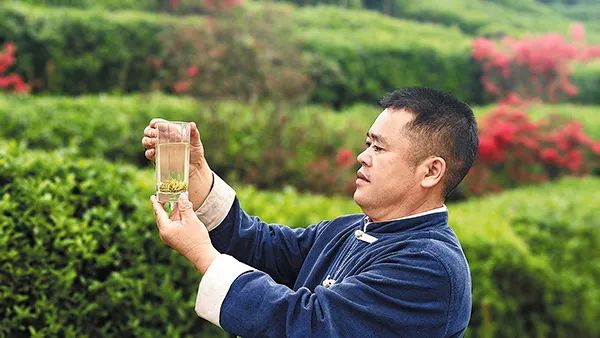dice Zhang.

▲ Zhang Ziquan shows a child how to tell the quality of tea leaves at his tea plantation in Pingyang village, Duyun city, Guizhou province.[Photo provided to China Daily]
The scene is from Zhang's plantation in Pingyang village, Maojian town, Duyun city, Qiannan Bouyei and Miao autonomous prefecture, Guizhou province. There, he practices an ancient art, innovates, follows his dream of being a tea maker, and contributes to the maintenance of China's cultural heritage.
As the tea leaves accumulate and the sun comes down, Zhang starts the frying process. The first step in frying tea is to remove the grassy taste from the tea leaves, he explains.
The emerald green tea leaves crackle as they come into contact with the burning pot. Zhang then stretches his hands into the pot, stirring up the leaves.
"The temperature of the pot needs to reach 250 to 300 C," says the Maojian native, who is in his 50s.
More than four decades of tea making has granted him the capacity to pull off the feat of sensing the high temperature through his bare hands.
"If I feel it is scorching, it is the right temperature," he says.
Zhang's hands have long been accustomed to high temperatures, and he can accurately sense the different temperatures required for frying tea, just like a thermometer.
After the frying, the rolling and kneading start. At this point, the temperature of the pot is maintained at around 80 C.
Zhang quickly rubs the tea leaves in his palms. After the process is complete, the astringency of the tea begins to fade, giving way to a pleasant, ripe flavor.
The third step is to roll the tea leaves into tight strips. Zhang then spends about five minutes pushing the tea leaves in a centrifugal motion around the pot until the leaves turn into a fishhook shape and all moisture is removed.

▲ Making tea with hot water is a routine test for Zhang to assess his products.[Photo provided to China Daily]
Next comes the tricky part, in which the pot temperature is rapidly raised to 120 C to continue roasting the tea
"The first 60 seconds of roasting is the most critical step," he says.
A layer of white fuzz (tea hair) will appear on the green tea leaves. The hair is considered an essential characteristic of the tea and is the main standard for evaluating its quality.
"If you stir-fry them over high heat and don't pay attention, the tea leaves will easily spoil," Zhang says. "It's just like stir-frying vegetables — the rhythm and the temperature of the pot must be coordinated, which requires a lot of experience and skill from the tea maker."
After the cooking is done, the temperature is dropped to 60 C, after which the tea leaves are pressed together in the palm and twisted into balls. While twisting, the leaves are continuously roasted for five minutes, which enhances their aroma.
At the end, Zhang fully dries, and then shrinks the tea leaves.
Zhang amazed everyone present at a recent Duyun Maojian tea demonstration event, as he had all the steps down to a fine art. With the simple tools of an iron pot, a mud stove and firewood, he could finish the whole process of making Duyun Maojian tea, whose production technique was put on UNESCO's intangible cultural heritage list last year.
"Tea leaves picked from the bushes must be processed on the same day, or else the aroma will be affected," he says.
Zhang's family has been making Duyun Maojian tea for four generations
At the age of 5, he started following his grandfather to pick tea leaves during the day and roast them at night.
"I was not even as tall as the stove, but whenever my grandfather roasted the tea, I would stand on my tiptoes and watch carefully," Zhang recalls.
He then memorized all key operations, such as how to grab, shake, twist, knead and flip tea leaves.
At the age of 12, his grandfather encouraged Zhang to try his hand at the art.
Under his grandfather's instructions, he successfully produced the tea's characteristic white hairs for the first time.
After the cooking is done, the temperature is dropped to 60 C, after which the tea leaves are pressed together in the palm and twisted into balls. While twisting, the leaves are continuously roasted for five minutes, which enhances their aroma.

▲ Zhang stirs tea leaves with his bare hands over a hot pot, which is an essential step to get rid of the grassy taste of tea.[Photo provided to China Daily]
"I was both nervous and excited," he says, adding that this childhood tea roasting experience has made him proud and planted the seeds of desire for him to make a career out of it.
The first year saw him make a profit of more than 1,500 yuan ($216.3), which was a lot of money at the time.
This outstanding performance soon brought attention to him, including from the head of the local tea processing plant.
He was soon recommended to be director at the processing plant, where he worked for the following 16 years.He acted on the dream in 2008 when Duyun came up with policies to develop the tea industry and encourage tea farmers to expand planting.
When Zhang heard the news, he was overjoyed and discussed with his wife his dream of building his own tea garden.
A tea processing plant was established, and ever since, Zhang and his team have been highly successful in the tea business.
Local authorities have also vigorously developed tourism based on tea culture, which has brought Zhang's craft more public attention.
"It was my first time experiencing the production of Duyun Maojian tea, and I found it very interesting," Liu says. "At the same time, I also see the difficulty of making it, and I will better appreciate it when I drink it."
"The key to successfully frying Duyun Maojian tea lies in precise control of the pot temperature," he explains.
Although Zhang has stuck to the traditions of his craft for decades, he has also innovated based on his experience.After seeing the problem, Zhang bought books to study fermentation and experimented over subsequent years, developing his signature "Golden Maojian" black tea with its unique aroma, rich taste and long shelf life.
The new tea has enjoyed brisk sales and greatly increased the utilization of local tea resources, bringing more income to local tea enterprises and farmers.
As Zhang's first dream of owning his own tea plantation has been realized, he has set his sights on a new dream — to have more people learn about tea roasting and share his love of it.
Dice che lo spera












